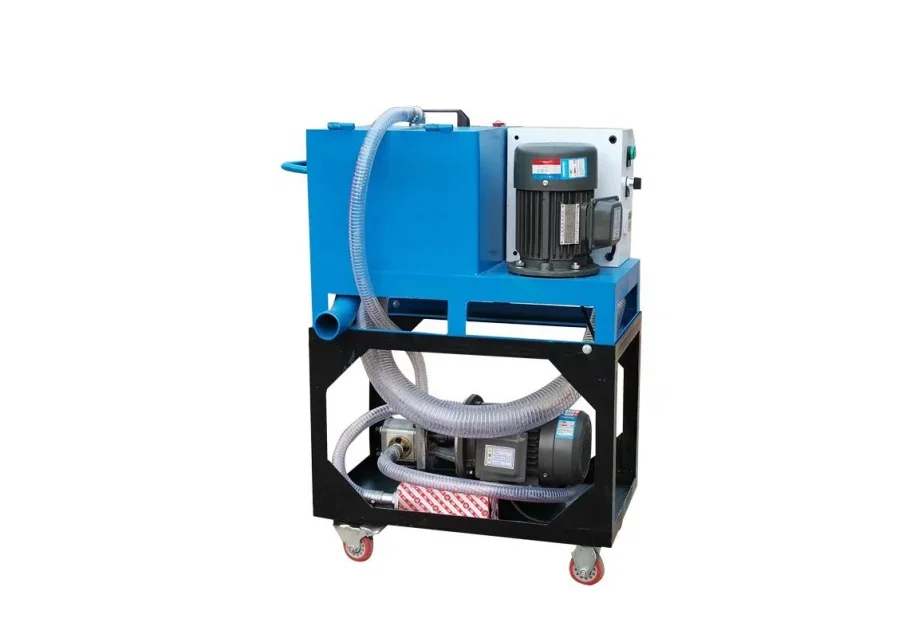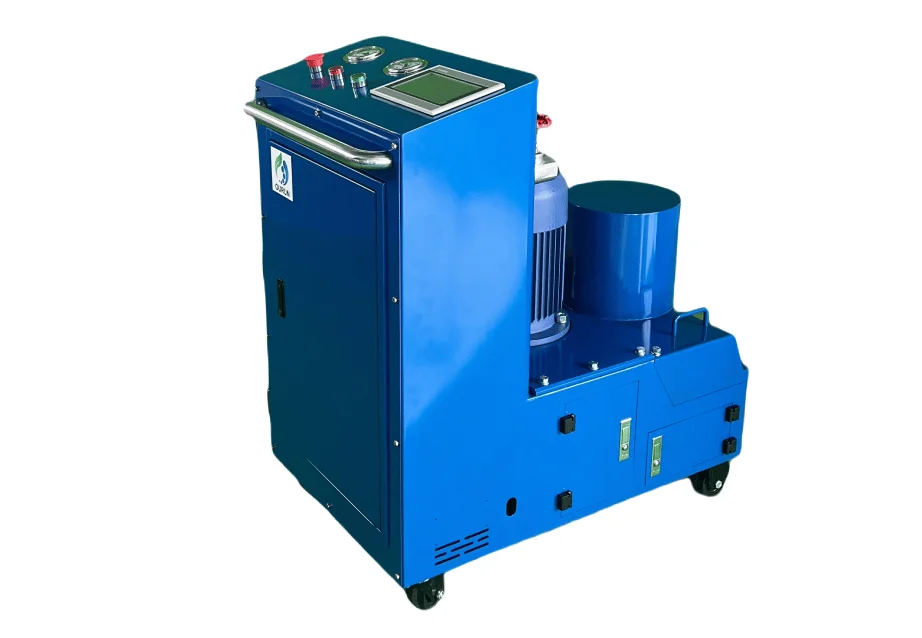
이 기사는 비교 기름 원심 필터 그리고 원심 분리기, 어떻게 작동하는지, 설계, 사용, 그리고 얼마나 잘 작동하는지 설명합니다. 오일 원심 필터 기름에서 더러움을 제거하기 위해 빠르게 회전하여 엔진에 좋습니다.그러나 원심 분리기는 공장에서 물과 기름과 같은 혼합 액체를 분리합니다.둘 다 회전력을 사용하지만, 분리기는 종종 더 어려운 작업을 위해 추가 단계를 가지고 있습니다. 오일 원심 필터 need little upkeep, while separators might need more care but can handle bigger amounts of liquid. Choosing between them depends on what dirt you’re removing, running costs, and how long they last. The article also suggests products and standards for best results.
운영의 기본 원칙은 무엇입니까?
기름 원심 필터는 실제로 어떻게 작동합니까?
한 기름 원심 필터 더러운 기름을 빠르게 회전하여 원치 않는 비트를 분리합니다.기름은 회전하는 드럼에 들어갑니다.금속 조각, 소트 또는 다른 고체 쓰레기와 같은 무거운 물건은 드럼의 옆에 던져 거기에 드드드립니다.깨끗한 기름은 중앙에 남아 있고 특별한 출구를 통해 흐릅니다.
이 도구는 원심 진공 기술을 사용하여 산업 기름에서 고체 더러움, 물 및 공기를 이 이 이 도구에서 제거합니다.쓰레기 필터 부품이 필요하지 않으며 시간이 지남에 따라 돈을 절약합니다.
원심 분리기 뒤에 있는 작동 원리는 무엇입니까?
원심 분리기는 비슷한 방식으로 작동하지만 더 큰 액체 분리 작업을 위해 구축되었습니다.그것은 다른 무게의 액체를 분류하거나 액체에 부동하는 작은 고체를 제거하기 위해 빠르게 회전합니다.공장에서는 물을 기름으로부터 분리하거나 유용한 윤활유를 폐기물으로부터 절약하기 위해 사용됩니다.
달리 an 기름 원심 필터엔진 오일을 깨끗하게 유지하는 데 초점을 맞추고 있는 원심 분리기는 기름이 많은 물이나 기기기름이 기기기름이 엔진 엔진 오일을 깨끗하게 유지하는 데 초점을 맞추고 있습니다.
어떤 물리적 힘이 각 시스템의 기능을 운영합니까?
두 시스템은 회전력에 의존하며, 더 무거운 비트는 회전할 때 더 빨리 외부로 이동합니다.사용하는 것과 같은 일부 고급 모델 진공 원심 복합 원리, 또한 진공 압력을 사용합니다.이것은 물을 더 잘 제거하고 에너지를 적게 사용하는 데 도움이 됩니다.

그들의 디자인과 구조는 어떻게 다르습니까?
어떤 내부 구성 요소가 흐름 경로와 분리 효율성을 정의합니까?
한 기름 원심 필터 회전실, 입구 및 출구 구멍, 드럼 안에 더러움을 수집하는 장소가 있습니다.회전하는 부분은 좋은 청소를 위해 기름이 부드럽게 움직이도록 설계되었습니다.
반면에 원심 분리기는 종종 분리실 또는 액체를 결합하기 위해 특별한 영역과 같은 추가 부품을 가지고 있습니다.이러한 부품은 혼합된 액체와 고체를 처리할 수 있도록 하므로 한 번에 더 많은 액체를 처리할 수 있습니다.
재료 건설은 내구성에 어떻게 영향을 미치는가?
두 시스템은 거친 조건에서 작동하기 어려워야합니다.강한 강철판과 정확하게 절단된 부품은 많은 고품질을 유지합니다. 기름 원심 필터 부드럽게 달리고 있습니다.또한 진공 진진공 또또또한 304 스테인리스 스틸은 또또또한 진공 또또한 진공 또또한 진공 또한 진공 또또한 진공 또또한 진공 또또또한 파이프에 있는 304 스테인
유지보수 요구 사항은 어떻게 비교합니까?
오일 원심 필터 일반적으로 쓰레기 부품을 사용하지 않기 때문에 더 적은 관심이 필요합니다.그냥 드럼을 때때로 청소하십시오.원심 분리기는 특히 가열 부품이나 여러 단계가 있다면 더 많은 관심이 필요할 수 있습니다.그러나 PLC 기반의 지능형 제어 시스템과 같은 스마트 시스템은 실제적인 작업이 줄어들어 실행하기 쉬워합니다.
그들의 기능적 목표와 응용 프로그램은 무엇입니까?
기름 원심 필터가 엔진 시스템에서 사용되는 이유는 무엇입니까?
A 의 주요 직업 기름 원심 필터 기름을 확인함으로써 엔진 부품을 안전하게 유지하는 것입니다 깨끗한 유지 오랫동안.일반적인 필터가 놓치는 작은 더러움을 제거하여 베어링과 피스턴과 같은 부품의 마모를 중단합니다.
이러한 필터는 빠른 디젤 엔진에서 잘 작동합니다.엔진 속도가 변경되거나 외부가 뜨거거거나 추운 경우에도 신뢰할 수 있습니다.
산업에서 일반적으로 적용되는 원심 분리기는 어디입니까?
Centrifugal separators are common in factories for cleaning liquids. They’re used to recycle coolant, clean hydraulic fluid, or purify quenching oil. They’re great for handling large amounts of mixed liquids without stopping.
이 장비는 원심 진공 원리로 구축되어 기름이 있는 액체에서 고체 더러움을 제거합니다.
어떤 메트릭스가 애플리케이션 특정 성능을 나타냅니까?
성과는 직업에 달려 있습니다.For 기름 원심 필터주요 측정은 드럼이 얼마나 많은 더러움을 가질 수 있는지 (1 kg 이상) 및 얼마나 빠르게 오일 흐름 (≥40 L/min)을 포함합니다.분리기의 경우 중요한 요인은 정확하게 분리하는 방법 (≤30 마이크론), 처리하는 액체의 양 (500-800 L/h), 최대 680 mm²/s의 두께의 액체로 작동하는 방법입니다.
효율성과 필터링 성능을 어떻게 비교합니까?
두 시스템은 미세한 입자를 효과적으로 처리할 수 있습니까?
예, 둘 다 작은 비트를 제거 할 수 있지만 약간 다릅니다. 오일 원심 필터 종종 간단한 디자인으로 인해 막히지 않고 20 마이크론까지 청소합니다.분리기는 또한 필요할 때 추가 필터 재료와 결합되면 이 수준에 도달할 수 있습니다.
The OURUN-KORS-40 수동 원심 기름 여과기 장비 ≤20 마이크론 (M)의 청소 수준과 분당 ≥40 리터 (L/min)의 출력 흐름을 달성합니다.
시간이 지남에 따라 석유 품질에 어떻게 영향을 미치는가?
두 시스템은 정규 필터의 섬유와 같은 원치 않는 물질을 추가하지 않고 오일을 깨끗하게 유지합니다.이것은 석유를 더 오래 지속하고 폐기물 비용을 줄입니다.오랫동안 깨끗한 기름을 유지하는 데 도움이 됩니다.
전력 차이는 어떻게 되나요?
원심 분리기는 보통 더 큰 방과 유연한 디자인이 있기 때문에 더 많은 액체를 처리합니다.하지만 현대적인 기름 원심 필터 스마트 컨트롤로 작은 기계나 작작은 공간에서 따라갈 수 있습니다.
기계에 통합할 때 필요한 것은 무엇입니까?
오일 필터에 대한 특정 설치 요구 사항이 있습니까?
예, 기름 원심 필터 모터를 손상시킬 수 있는 압력 축적을 방지하기 위해 오일 출구 지점 아래에 배치해야합니다.또한 전기 위험을 피하기 위해 적절하게 접지되어 있는지 확인하십시오.
출구 파이프가 배출 포트보다 높지 않는지 확인하십시오. 또는 모터를 스트레스할 수 있습니다.
분리기는 기존 가공 장비와 얼마나 호환합니까?
원심 분리기는 표준 파이프 연결을 사용하여 현재 시스템에 쉽게 적합하도록 구축되었습니다.그들은 두께의 액체 (1-680 mm²/s)를 처리하고 무거운 프레스나 전기 방전 기계와 같은 거친 설정에 충분히 견고하기 때문에 많은 산업에서 작동합니다.
시간이 지남에 따라 운영 비용에 대해 알아야 할 것은 무엇입니까?
작업 중에 더 많은 에너지를 소비하는 것은 무엇입니까?
두 시스템은 모터를 사용하여 회전하지만, 스마트 컨트롤은 에너지를 절약하는 데 도움이 됩니다. 예를 들어, a 국립 표준 인증 전기 모터 효율적으로 운영하고 국가 규칙을 준수합니다.
시간이 지남에 따라, 쓰레기 부품을 사용하지 않는 디자인은 지속적으로 교체해야하는 필터에 비해 비용을 줄입니다.
다운타임 또는 교체 부품이 얼마나 자주 필요합니까?
오일 원심 필터 여기서 훌륭합니다: 그들의 간단한 디자인은 더 적은 부품 부서를 의미합니다.일반적으로 드럼을 정기적으로 청소하는 것이 충분합니다.일부 모델에는 유지보수를 쉽게 하기 위해 자동 배수도 있습니다.
당신이 따라야 할 산업 표준이 있습니까?
어떤 ISO 표준이 적용되나요?
여과 시스템은 ISO 청결성 코드를 따라야 합니다. ISO 4406의입자를 계산하거나 NAS1638은 초청결한 유압 기름 (청결성 수준은 NAS1638 5-7에 도달할 수 있습니다).또한 환경 안전을 보장합니다 (RoHS는또는 압력 용기 규칙, 지역 법률에 따라.
응용 시나리오에 기초한 Ourun 제품 추천
훌륭한 엔지니어링으로 지원되는 신뢰할 수 있는 도구를 원한다면, 확인하십시오. 우리 unPLC 자동화와 제로 소비 디자인을 사용하는 스마트 필터링 기술의 선도자입니다.
고속 디젤 엔진용: 고효율 오일 원심 필터 시리즈 OCF-X
해양 엔진, 발전기 및 중량 트럭을 위해 만들어진:
- 주요 특징: 오래 지속되는;낮은 유지보수;작은 크기.
- 권장 사용: 제한된 공간을 가진 높은 소트 엔진을 위해 가장 좋습니다.
산업용 액체 분리 요구를 위해: 정밀 원심 분리기 시리즈 CS-PRO
힘든 공장 설정을 위해 만들어진:
- 주요 특징: 정확한 분리;강한 강철 건축;확장가능한 디자인.
- 권장 사용: 유압 액체 청소 또는 윤활유 회복을 위해 좋습니다.
이 두 가지 기술 사이에서 어떻게 선택해야 합니까?
오염 유형이 당신의 결정에 가장 심각한 영향을 미치는가?
예, 선택하세요 기름 원심 필터 당신이 주로 압력 아래 시스템에서 윤활 기름에서 고체 더러움을 제거하는 경우.기름에서 물을 분리하거나 여러 유형의 액체를 처리해야 하는 경우 분리기를 선택하십시오.
초기 비용보다 장기적인 신뢰성을 우선순위로 주어야 합니까?
분리기는 난방과 같은 추가 기능으로 인해 사전 비용이 더 높을 수 있지만 복잡한 공장 작업에 가치가 있습니다. 오일 원심 필터그러나 안정적인 성능이 가장 중요한 경우 큰 가치를 제공합니다.
FAQ는
Q1: 분리기 대신 오일 원심 필터를 사용할 수 있습니까?
A: 단단 단계 시스템에서 윤활유로부터 고체 더러움을 청소하는 경우에만.물-기름 분리나 혼합된 액체를 위해 분리기를 사용하십시오.
Q2: 각 시스템은 어떤 유지보수를 필요로 합니까?
A: 오일 원심 필터 때때로 드럼 청소가 필요합니다.분리기에는 검사 모듈이 필요할 수 있지만 스마트 PLC 시스템은 수동 작업을 줄입니다.
Q3: 이 시스템은 고점도 기름에 적합합합니까?
A: 예, 모두 680 mm²/s까지 기름을 처리하고 극단적인 온도에서 잘 작동합니다 (-40℃에서 300℃).






